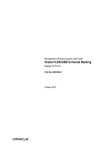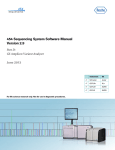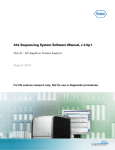Download Management Information System Version-1.0 9NT1399
Transcript
Management Information System Version-1.0 9NT1399-ORACLE FCUBSV.UM 11.0.RU.1.0.0.0 [December] [2010] Oracle Part Number E51712-01 Document Control Author: Documentation Team Group: UBPG Created on: October 01, 2008 Revision No: Final Updated by: Documentation Team Reviewed by: Development/Testing teams Approved by: Software Quality Assurance Team Updated on: December 23, 2010 Reviewed on: December 23, 2010 Approved on: December 23, 2010 Management Information System Table of Contents 1. ABOUT THIS MANUAL................................................................................................................................ 1-1 1.1 INTRODUCTION ........................................................................................................................................... 1-1 1.2 AUDIENCE .................................................................................................................................................. 1-1 1.3 ORGANIZATION .......................................................................................................................................... 1-1 1.4 GLOSSARY OF ICONS .................................................................................................................................. 1-2 1.4.1 Related Documents ............................................................................................................................ 1-3 2. DEFINING MIS CLASS CODES .................................................................................................................. 2-1 2.1 INTRODUCTION ........................................................................................................................................... 2-1 2.1.1 Invoking the MIS Class screen ........................................................................................................... 2-1 2.2 MIS TYPE ................................................................................................................................................... 2-2 2.2.1 Budget for this MIS class ................................................................................................................... 2-4 2.2.2 MIS Code ........................................................................................................................................... 2-4 2.2.3 Operations on the MIS Class record ................................................................................................. 2-5 3. DEFINING MIS COST CODES .................................................................................................................... 3-1 3.1 INTRODUCTION ........................................................................................................................................... 3-1 3.1.1 Invoking the MIS Cost Codes screen ................................................................................................. 3-1 3.1.2 Type ................................................................................................................................................... 3-2 3.1.3 Cost .................................................................................................................................................... 3-3 3.1.4 Periodicity.......................................................................................................................................... 3-3 3.1.5 Operations on the MIS Cost Code record .......................................................................................... 3-3 4. DEFINING AN MIS GROUP......................................................................................................................... 4-1 4.1 INTRODUCTION ........................................................................................................................................... 4-1 4.1.1 Invoking the MIS Group screen ......................................................................................................... 4-2 4.1.2 Operations on the MIS Group record ................................................................................................ 4-3 4.1.3 MIS Cascading................................................................................................................................... 4-3 4.1.4 Feature ID Maintenance .................................................................................................................... 4-3 5. DEFINING MIS HEADS ................................................................................................................................ 5-1 5.1 INTRODUCTION ........................................................................................................................................... 5-1 5.1.1 Invoking the MIS Heads screen ......................................................................................................... 5-1 5.1.2 Category ............................................................................................................................................ 5-1 5.1.3 Refinance ........................................................................................................................................... 5-2 5.1.4 Linking an MIS Head to an accounting entry .................................................................................... 5-2 5.1.5 Operations on the MIS Head record .................................................................................................. 5-3 6. DEFINING POOL CODES AND REFINANCING RATES ....................................................................... 6-1 6.1 INTRODUCTION ........................................................................................................................................... 6-1 6.1.1 Invoking the MIS Pool Code screen ................................................................................................... 6-1 6.2 DEFINING REFINANCING RATES FOR A POOL ............................................................................................... 6-2 6.2.1 Invoking the MIS Pool Refinancing Rates screen .............................................................................. 6-2 6.2.2 Operations on the MIS Pool Refinancing Rates record ..................................................................... 6-3 7. MAKING MIS ADJUSTMENTS FOR A POOL ......................................................................................... 7-1 7.1 INTRODUCTION ........................................................................................................................................... 7-1 7.1.1 Invoking the MIS Adjustments screen ................................................................................................ 7-1 7.1.2 Operations on the MIS Adjustments screen ....................................................................................... 7-2 8. DEFINING MIS DETAILS FOR A CUSTOMER, ACCOUNT CLASS, ACCOUNT, PRODUCT, AND CONTRACT ............................................................................................................................................................ 8-1 8.1 DEFINING MIS DETAILS FOR A CUSTOMER.................................................................................................. 8-1 8.2 MIS DETAILS FOR AN ACCOUNT CLASS AND A PRODUCT ............................................................................ 8-3 8.2.1 Invoking the MIS details screen for an account class ........................................................................ 8-3 8.2.2 Invoking the MIS details screen for a product ................................................................................... 8-4 8.2.3 Specifying the MIS details for an account class and a product ......................................................... 8-4 8.3 DEFINING MIS DETAILS FOR AN ACCOUNT OR CONTRACT .......................................................................... 8-5 8.3.1 Invoking the MIS details screen for a contract .................................................................................. 8-5 8.3.2 Invoking the MIS details screen for an account ................................................................................. 8-7 8.4 GL MIS BALANCE TRANSFERS DUE TO RECLASSIFICATION ........................................................................ 8-8 9. REPORTS ........................................................................................................................................................ 9-1 9.1 INTRODUCTION ........................................................................................................................................... 9-1 9.2 INVOKING THE REPORT OPTIONS SCREEN .................................................................................................. 9-2 9.2.1 Invoking the Management Information System Profit and Loss Report Screen ................................. 9-2 9.2.2 Contents of the Report ....................................................................................................................... 9-3 9.2.3 Invoking the Pool Codes Report Screen ............................................................................................ 9-4 9.2.4 Contents of the Report ....................................................................................................................... 9-4 9.2.5 Invoking the Error Report Screen ...................................................................................................... 9-5 9.2.6 Contents of the Report ....................................................................................................................... 9-6 1. About this Manual 1.1 Introduction This manual is designed to give you an understanding of the Management Information System module of Oracle FLEXCUBE. Apart from assisting you in generating reports, this manual guides you in the definition and maintenance of MIS classes and cost codes, MIS groups, MIS heads, MIS pools and refinancing rates. You are also taught how to define MIS details for a customer, an account class, a product and a contract. 1.2 Audience This manual is intended for the Customer Service Representatives (CSRs) and the bank staff in charge of setting up new products in your bank. 1.3 Organization This manual is organized as follows: Chapter 1 About this Manual gives information on the intended audience. It also lists the various chapters covered in this User Manual. Chapter 2 Defining MIS Class Code describes how to define MIS classes and link them to several entities. Chapter 3 Defining MIS Cost Codes explains the procedure for defining and maintaining MIS cost codes. Chapter 4 Defining an MIS Group describes in detail how the definition of an MIS group simplifies the process of associating an account, product or a transaction to several other entities. Chapter 5 Defining MIS Heads describes the procedure for defining MIS heads. This includes the linking of an MIS head to an accounting entry, indicating whether the MIS head should be considered for refinancing and the operations that can be performed on an existing MIS head record. Chapter 6 Defining Pool Codes and Refinancing Rates explains how to assign unique codes to MIS pools and how, for each pool, you can maintain refinancing rates in different currencies. Chapter 7 Making MIS Adjustments for a Pool specifies the manner in which you can allocate the amounts to be reported from one MIS code to another. Chapter 8 Defining MIS details for a Customer, Account Class, Product and Contract enumerates the steps that you should follow while defining MIS details for a customer, an account class, a product or a contract. Chapter 9 Reports provides a list of reports that can be generated in this module and also explains their contents. 1-1 Conventions Used in this Manual Important information is preceded with the 1.4 symbol. Glossary of Icons This User Manual may refer to all or some of the following icons. Icons Function New Copy Save Delete Unlock Print Close Re-open Reverse Template Roll-over Hold Authorize Liquidate Exit Sign-off Help Add Delete 1-2 Refer the Procedures User Manual for further details about the icons. 1.4.1 Related Documents For a detailed description of all the procedures in the manual please refer to the Oracle FLEXCUBE manual on Common Procedures. For a detailed description of shadow processing, please refer the Shadow Processing User Manual under Core. 1-3 2. Defining MIS Class codes 2.1 Introduction In simple terms, an MIS Class represents a type of entity based on which you want your reporting to be done. An MIS Class will be the most general definition for MIS reporting, under which you can have several entities. For example, if you want reports on the profitability of accounts officers, you would define Accounts Officer as an MIS Class. Accounts Officers in your bank would report to this MIS Class. Similarly, you define Cost Center as an MIS Class if you want reports based on the cost centers in your bank. You can have the various cost centers in your bank linked to the MIS Class of Cost Center. Business Segment, Industry Segments are other examples of an MIS Class. The definition of MIS Class renders the entire MIS reporting absolutely flexible. By defining a class of your choice, and linking several entities to it, you can generate management information as per your requirement. In a centralized database architecture, an MIS Class is defined in the Head Office branch of your bank, and is used by all the branches on the database. 2.1.1 Invoking the MIS Class screen You can invoke the ‘MIS Class Maintenance’ screen by typing ‘GLDCLASS’ in the field at the top right corner of the Application tool bar and clicking on the adjoining arrow button. 2-1 If you are creating a new MIS Class, select ‘New’ from the Actions Menu in the Application toolbar or click new icon. The ‘MIS Class Maintenance’ screen is displayed without any details. If you are calling an MIS Class that has already been defined, double-click on an MIS Class from the summary screen. 2.2 MIS Type The most basic attribute of an MIS class is the ‘type’ of its class. An MIS class can belong to one of the following types: Transaction Class Customer Class Composite Class Fund Class Allocation Class The MIS type helps you classify your reporting based on either, a customer or a transaction. An MIS Class belonging to the Customer class type helps you generate your profitability for a customer. Similarly, MIS Class belonging to the Transaction class type helps you generate your profitability report based on transactions. A Composite class type, as the name indicates, would help you group a Customer and Transaction type classes. Choose an MIS Type for an MIS Class using the option button beside it. 2-2 Transaction Class A Cost Center would be a typical transaction type of MIS class. For a cost center, you would want to generate reports for the kind of costs incurred for processing a transaction. For example, ‘short term loans’ may be a cost center. For this cost center, you can generate a report that gives the details of the cost of processing each transaction. All the cost centers of your bank, would ideally be the different departments of your bank like short term loans, long term loans, teller, bills, etc. Each of these can be defined as MIS Codes, and linked to it. Customer Class You may want a profitability report based on the type of industry (manufacturing, agriculture, mining, financial institutions, etc.) to which a customer belongs. For achieving this, you would define Industries as an MIS class, and have various MIS codes linked to the class for each type of industry: manufacturing, agriculture, mining, financial institution, etc. This MIS class would be of Customer class type. Composite Class A ‘composite’ class is simply, a combination of a customer and a transaction type of MIS class. Typically, an Accounts Officer would be handling several customers, and you would want a report of the profitability of each customer. Occasionally, a customer may begin with one Accounts Officer and use a product or service that folds under some other Accounts Officer. In such a requirement, you work backwards and create an MIS Class called Accounts Officer. All the accounts officers of your bank will be created as MIS Codes under this MIS Class. When you are generating your profitability reports, you can choose to get the figures for all the accounts officers, or for a selected few. Also, you can change the Accounts Officer that is picked up by default. Allocation Class You may want to view details of the expenses incurred by your bank. To do this, you can maintain Allocation Classes by which you can allocate the various expenses to different entities within your bank. For instance, let us assume that your organization has over 2000 employees spread across four different locations (Delhi, Mumbai, Chennai, and Calcutta) in India. You would like to have a location-wise break-up of the salary amount disbursed to each of these locations. Additionally, you would also like to view a break-up of balances for individual departments within each location. To meet these requirements in Oracle FLEXCUBE firstly, define an MIS Class called Locations. All the four location of your organization - Delhi, Mumbai, Chennai, Calcutta, will be created as MIS Codes under this MIS Class. Similarly, create another MIS Class called Departments. All the departments within your organization (Administration, Financial Control, Products Division, IT Solutions etc) will be created as MIS Codes under this MIS Class. 2-3 Consequently, details of salary expenses incurred across-locations will be available under the MIS Class called Locations. The department-wise salary disbursement details will be available under the MIS Class called Departments. Both these MIS classes will be of the Allocation Class type. Fund Class Your bank may float a number of funds like Mutual Funds, Growth Funds, and Income Funds etc. You may want to view details on each of the funds. You can achieve this by defining Funds as an MIS Class and have the various funds reporting to it. Each of these funds would be defined as an MIS Code and then linked to the MIS Class ‘Funds’. This is a Fund type of MIS Class. 2.2.1 Budget for this MIS class For certain MIS classes, you may want to define a budget for turnover and revenue. Since defining a budget may not be necessary for all MIS classes, you should indicate whether a budget would be allocated to the class while defining the class. For those MIS classes that require a budget, you should define the budget through the GL Budget Maintenance screen. The same is discussed in subsequent chapters. Under each MIS Type, you can only define two MIS classes for budget allocation. Use the check box next to ‘Budget for this MIS Class’ to select this option. Example You have defined the following number of MIS classes, under each type: Customer type 10 Transaction type 10 Composite type 5 You can choose to allocate a budget for only two classes under each type. Thus, in total, you would have six classes, two under each type, for budget allocation. 2.2.2 MIS Code An MIS Code can be called an entity for which you want profitability reports. Each MIS Code will report to an MIS Class. Consider the following examples: Accounts Officer is an MIS Class. To this MIS Class will report all the Accounts Officers of your bank. With this structure, you can generate profitability reports for each Accounts Officer. Elizabeth Towers, Sam Brown, and Connie Beckwith, are some of your accounts officers. Cost Center is an MIS Class. The various cost centers in your bank will be classified under this MIS Class. Thus, the various departments in your bank will report to this Cost Center, so that you can generate profitability reports for each cost center. Short Term Loans, Incoming Bills, and Import Letters of Credit can be some of your cost centers. Industry Segments is an MIS Class. The various industries to which your customers belong will report to this MIS Class. Manufacturing, agriculture (cash crops) and financial institutions can be some of your industry segments. 2-4 In these examples, Elizabeth Towers, Sam Brown, and Connie Beckwith will each have an MIS Code, all under the MIS Class 'Accounts Officer'. Similarly, Short Term Loans, Incoming Bills, and Import Letters of Credit will have an MIS Code each, under the MIS Class 'Cost Center'. The same concept applies to Industry Segments also. An MIS Code is added on to an MIS Class either through the New operation on the MIS Class screen or through the ‘Amend’ option on an existing MIS Class record. Once an MIS Class has been stored, you can add MIS Codes to it by unlocking the MIS Class record and adding the required MIS Code. The ‘MIS Code’ list contains the MIS Codes attached to the selected MIS Class. To add a new record to the ‘MIS Code’ list, click add icon. To delete an MIS Code(s) from the list, choose the MIS code(s) using the checkbox next to it and then click delete icon. 2.2.3 Operations on the MIS Class record On an existing MIS Class record, you can perform the following operations (if any function under the Actions Menu is disabled, it means that the function is not allowed for the record): Amend the details of an MIS Class Authorize an MIS Class Copy the details of an MIS Class on to a new one Print the details of an MIS Class Delete an MIS Class To facilitate accounting for the same transaction based on different GAAPs, certain maintenances of the module will be replicated in a second schema, which is the shadow schema. The shadow schema has a GAAP different from the one in which the original operation is carried out (the main schema). This ensures that accounting is done in accordance with both GAAPs for operations requiring such accounting treatment. Refer the chapter ‘Shadow Processing’ in the Shadow Processing User Manual under Core for details on the other maintenances that are replayed for this module and the shadow processing feature Please refer to the manual on common procedures for details of these operations. 2-5 3. Defining MIS Cost Codes 3.1 Introduction An MIS cost code represents the notional cost incurred for a transaction. An MIS cost code can be attached either to an account or to a contract, in the following manner: 1. You can link a Cost Code to an account class. This will default to the accounts maintained under the account class. You can change this default. Alternatively, you can link an MIS Cost Code to an account when maintaining it. 2. When creating a product, you can identify the Cost Codes against which contracts involving the product should be reported. 3. When processing a contract, the Cost Codes identified for the product (the contract involves) will automatically default. These defaults can be changed. If cost codes have not been identified for the product, you can identify one for the contract. The notional cost will be reported in the profitability report. 3.1.1 Invoking the MIS Cost Codes screen If you are creating a new MIS Cost Code, select ‘New’ from the Actions Menu in the Application toolbar or click new icon. The ‘MIS Cost Code Maintenance’ screen is displayed without any details. If you are calling an MIS Cost Code that has already been defined, double-click on an MIS Cost Code from the summary screen. 3-1 3.1.2 Type The MIS Cost Code can belong to one of the following types: Number of transactions This typically applies for calculating the cost of processing a transaction involving an account. You can indicate the amount to be considered as the notional cost for each transaction. Example You may incur a certain amount for every transaction you process of a savings account a particular category. This cost could be different for processing transactions in a different type of savings account or for current accounts. You should define different MIS Cost Codes and link them to the appropriate account classes. Event based charges The notional cost applicable for processing an event can be defined as a cost code. Typically, this applies for a contract. Example For processing an event in the lifecycle of a loan, you may want to attach a certain cost. You can define a cost code for it and link it to the product. Similarly, you can define a different notional cost for different events in the lifecycle of a contract. Thus, you can have a cost code for initiating a loan, one for liquidating interest, and so on, and link them to the product with the appropriate event codes. The notional cost that you define will be taken as the cost per event. Duration based charges These changes are applied typically for a contract. The notional cost in this case, is calculated on the basis of a specific duration. This notional cost is defined for a cost code. The following example illustrates how this cost is applied on a contract. Example If a loan is live for a month, the notional cost you incur is a specific amount. You would define a duration based cost code, define the periodicity as 'monthly'. For every month a loan linked to the cost code is live, the notional cost will be applied. 3-2 3.1.3 Cost The notional cost, along with the currency in which it is expressed should be indicated for the cost code. The cost will be applied based on the Cost Code type, as follows: Number of transactions The amount is taken as the cost per transaction Event The amount is taken as the cost per event Duration The amount is taken as the cost for the period defined as the periodicity, for the cost code If a currency conversion is involved during reporting, the prevailing conversion rate will be used. 3.1.4 Periodicity This is the periodicity at which the costs defined have to be applied. In the profitability report, the notional cost reported would depend on the periodicity defined for the cost code. For a quarterly, half-yearly or yearly periodicity, you should also indicate the first month of application. The subsequent application months would be computed based on this. 3.1.5 Operations on the MIS Cost Code record On an existing MIS Cost Code record, you can perform any of the following operations (if any function under the Actions Menu is disabled, it means that the function is not allowed for the record): Amend the details of an MIS Cost Code Authorize an MIS Cost Code Copy the details an MIS Cost Code on to a new one Print the details of an MIS Cost Code Delete an MIS Cost Code Please refer to the manual on Common Procedures for details of these operations. 3-3 4. Defining an MIS group 4.1 Introduction The definition of an MIS group simplifies the process of linking an account, product, or a transaction to several MIS entities. Consider the following example: Example Savings accounts in the local currency are a type of account class. This class may come under the purview of the following MIS entities: Business Segment Individuals. Cost center Savings accounts in local currency. Accounts officers Elizabeth Towers and Sam Brown. Cost Code Transaction charges for savings accounts. The following are the definitions in the various MIS screens: MIS Class MIS Code Business Segment Individuals Cost Center Savings Accounts Accounts Officer Elizabeth Towers and Sam Brown In the MIS Cost Codes screen, a Cost Code has been defined for the transaction charges for savings accounts. The pool for this class of accounts is called SAVINGS. When you create this account class, you do not have to individually link each applicable MIS entity to the account class. Instead, you can create an MIS Group with the MIS Class and MIS Code linked, as follows: MIS Group SAVE1 Pool SAVINGS Customer class Business segment (MIS Code Individuals) Transaction class Accounts Officer (no MIS Codes) Transaction class Cost Center (savings accounts in local currency) Cost code Code defined for transaction charges on savings accounts. While defining the account class, you can link the MIS Group SAVE1 to it, and indicate the appropriate accounts officer code, that for Elizabeth Towers or Sam Brown. 4-1 In a similar fashion, MIS Groups can be defined in various ways and used for linking MIS entities to an account class, account, product, or transaction. 4.1.1 Invoking the MIS Group screen You can invoke the ‘MIS Group Maintenance’ screen by typing ‘MIDGROUP’ in the field at the top right corner of the Application tool bar and clicking on the adjoining arrow button. If you are creating a new MIS Group, select ‘New’ from the Actions Menu in the Application toolbar or click new icon. The ‘MIS Group Definition’ screen is displayed without any details. If you are calling an MIS Group that has already been defined, double-click an MIS Group from the summary screen. 4-2 4.1.2 Operations on the MIS Group record On an existing MIS Group record, you can perform any of the following operations (if any function under the Actions Menu is disabled, it means that the function is not allowed for the record): Amend the details of an MIS Group Authorize an MIS Group Copy the details an MIS Group on to a new one Print the details of an MIS Group Delete an MIS Group Please refer to the manual on common procedures for details of these operations. 4.1.3 MIS Cascading You can have a particular MIS group defaulted in the MIS Subsystem of the following screens at the time of creation of records: Customer Maintenance Screen Account Class Maintenance Screen Customer Account Maintenance Screen All the Products Screens All the Contract Screens Once these records are authorized, you can change the MIS Group values (i.e. MIS Codes linked to the MIS Class) in the MIS Group Maintenance screen. During EOD, the batch program ‘MIGCASCD’ maintained at the Post EOTI level will cascade the modified MIS Codes in the above screens. As a result, the system replaces the MIS Codes that are provided at the time of creation of the above records by the MIS Codes maintained in MIS Group. 4.1.4 Feature ID Maintenance If you maintain feature ID for all branches, the system displays the MIS class values and MIS codes in the MIS subsystem of the following screens. Customer Maintenance Screen Account Class Maintenance Screen Customer Account Maintenance Screen All the Products Screens All the Contract Screens 4-3 5. Defining MIS heads 5.1 Introduction Each accounting entry that is generated can be linked to an MIS Head. An MIS Head indicates the manner in which the type of entry should be considered for profitability reporting purposes. 5.1.1 Invoking the MIS Heads screen If you are creating a new MIS Head, select ‘New’ from the Actions Menu in the Application toolbar or click new icon. The ‘MIS Head’ screen is displayed without any details. If you are calling an MIS Head that has already been defined, double-click an MIS Head from the summary screen. 5.1.2 Category The MIS Head Category classification indicates the method in which the accounting entry will be reported in the profitability report. It could be one of the following: Balance Indicates that the accounting entry should be considered for calculating the Cumulative Average Balance. Typically, an asset entry would be classified under the balance type MIS Head. The GL entry leg of a loan disbursement transaction, would typically be classified under a Balance type of MIS Head. 5-1 Income Indicates that the accounting entry should be considered as an income for the purpose of profitability reporting. Clearly, any interest or charge income would be classified under an Income type of MIS Head. Expense Indicates that the accounting entry should be considered as an expense for the purpose of profitability reporting. Any interest, postage, or tax expense would be classified under an expense type of MIS Head. Contingent Indicates that the accounting entry should be considered as a contingent entry for the purpose of profitability reporting. A forward FX deal, the issue of an import Letter of Credit, etc., are examples of contingent type of entries. You can generate a report that gives the balances due to such contingent type of entries. Under each type of MIS Head, you may define additional MIS Heads, as per your reporting requirement. For example, you can have an MIS Head for each loan product, so that you can have the cumulative average balance due to all the loans disbursed under the product. 5.1.3 Refinance The ‘Refinance’ option is provided for marking MIS Heads for refinancing. For MIS Heads that are marked for refinancing, the refinancing income or expense would be calculated, on the cumulative average balance, for the reporting period. You would typically mark a balance type of MIS Head for refinancing. This option is provided because not all the balance type of entries would come under the umbrella of refinancing. To enable this option select the check box beside ‘Refinance’. 5.1.4 Linking an MIS Head to an accounting entry Each accounting entry generated in Oracle FLEXCUBE will have a transaction code that describes the nature of the entry. These transaction codes are defined by you, depending on your requirements. An MIS Head can be attached to a transaction code. A transaction code is attached to an accounting entry when an event is defined for a product, through the ‘Product Event Accounting Entries Maintenance’ screen. Thus, whenever a transaction with an MIS Head attached is entered for an entry, the MIS Head will automatically be linked to it. You can change this while defining the product. Alternatively, you can link an MIS Head to an accounting entry directly while defining the product. 5-2 You should link the appropriate leg of the accounting entry to the MIS Head to which it belongs. Ensure that you link only one leg of the entry to an MIS Head. To add a record to the list of ‘Accounting Entries’ click add icon. Choose values for each field of a record using the adjoining option list. 5.1.5 Operations on the MIS Head record On an existing MIS Head record, you can perform the following operations (if any function under the Actions Menu is disabled, it means that the function is not allowed for the record): Amend the details of an MIS Head Authorize an MIS Head Copy the details an MIS Head on to a new one Print the details of an MIS Head Delete an MIS Head Please refer to the manual on common procedures for details of these operations. 5-3 6. Defining Pool Codes and Refinancing Rates 6.1 Introduction Each logical pool that will lend or borrow funds should be allocated a pool code. The interest method to be used while applying refinancing rates for the pool should be defined for the pool code also. The refinancing rates for the pool should be defined in the MIS Pool Refinancing Rates screen. 6.1.1 Invoking the MIS Pool Code screen You can invoke the ‘MIS Pool Code Maintenance’ screen by typing ‘MIDPOOLD’ in the field at the top right corner of the Application tool bar and clicking on the adjoining arrow button. If you are creating a new MIS Pool Code, select ‘New’ from the Actions Menu in the Application toolbar or click new icon. The ‘MIS Pool Code Definition’ screen is displayed without any details. If you are calling an MIS Pool Code that has already been defined, double-click on an MIS Pool Code from the summary screen. 6-1 6.2 Defining refinancing rates for a pool For each pool, you can define refinancing rates for every month of the year, for different currencies. The refinancing rate will be used to arrive at the refinance income and expense for a given MIS entity. Two types of refinancing rates can be defined: debit rate and credit rate. The debit rate is applied when the cumulative average balance calculated for the MIS entity is positive. This indicates that the MIS entity has borrowed funds. The credit rate is applied when the cumulative average balance calculated for the MIS entity is negative. This indicates that the MIS entity has lent funds. The refinancing rates are defined for each branch of your bank, individually. 6.2.1 Invoking the MIS Pool Refinancing Rates screen If you are creating MIS Pool Refinancing rates for a new pool, select ‘New’ from the Actions Menu in the Application toolbar or click new icon. The ‘MIS Pool Refinancing Rates’ screen is displayed without any details. If you are calling an existing MIS Pool Code, double-click on an MIS Pool Code from the summary screen. 6-2 Once the refinancing rates have been defined for a month, for a Pool Code-currency combination, you should use the Amend option for maintenance screens to input the rates applicable for the subsequent months. The rates for a month in the past can also be defined. If the rates have not been defined for a specific month, the latest rates available in the screen will be picked up. For example, you have defined rates for the months of January and February of the year 1998. You are in April now and there is no rate for March 1998. The rate defined for February 1998, being the latest available in the screen, will be picked up for March also. 6.2.2 Operations on the MIS Pool Refinancing Rates record On an existing MIS Pool Refinancing Rates record, you can perform any of the following operations (if any function under the Actions Menu is disabled, it means that the function is not allowed for the record): Amend the rates Authorize the addition or amendment of the rates Copy the details from one pool code to another Print the details of the refinancing rates Delete the refinancing rates for a pool Please refer to the manual on common procedures for details of these operations. 6-3 7. Making MIS adjustments for a pool 7.1 Introduction Within a pool, you may sometimes want to allocate the amounts to be reported from one MIS Code to another. This concept is explained through the following example: Example The Financial Control (FINCON) department in your bank is the one that disburses the salaries for your staff. This department is defined as an MIS Code under the MIS Class Cost Center. Now, there are other cost centers, such as: loans department, time deposits department, trade financing department and retail banking department. When the salary is disbursed by the FINCON department every month, a debit entry shown for the MIS Code FINCON. The burden of this debit entry should be shared appropriately by the various departments to which the staff of your bank belong. This distribution of the salary amount is done through the MIS adjustments screen. Thus, MIS adjustments can be done between two MIS Codes, which belong to the same pool, and MIS Class. 7.1.1 Invoking the MIS Adjustments screen You can invoke the ‘MIS Adjustment Maintenance’ screen by typing ‘MIDADJ’ in the field at the top right corner of the Application tool bar and clicking on the adjoining arrow button 7-1 Select ‘New’ from the Actions Menu in the Application toolbar or click new icon to input the details of an adjustment. The ‘MIS Adjustments’ screen is displayed without any details. You can input the following details of the adjustment. Reference Number Pool Code MIS Class MIS Head Currency Adjustment Details and Time Details You have to specify the following details while doing an adjustment: The pool code, MIS Class and MIS Head under which you want to make the adjustment. The currency in which the adjustment amount is represented. The MIS Code from which the amount should be moved (the debit MIS Code). The MIS Code to which the amount should be moved (the credit MIS Code). The amount that has to be moved or adjusted. The period for which the adjustment should be considered (represented through the month and the year under the ‘Time Details’). Depending on the type of MIS Head - balance, income, expense, or contingent, the adjusted amount will be reported accordingly, for the appropriate period. 7.1.2 Operations on the MIS Adjustments screen Once you input the details of an adjustment, it should be authorized by a user bearing a different Login ID from yours. Please refer to the manual on common procedures for details of these operations. 7-2 8. Defining MIS details for a Customer, Account Class, Account, Product, and Contract 8.1 Defining MIS details for a customer The MIS details for a customer can be defined through the ‘MIS’ screen. This screen can be invoked by clicking on the ‘MIS’ button while defining the customer code. The ‘MIS’ details screen for a customer is shown below. While defining a customer, you can define the following MIS details: MIS Group The MIS Group to which the customer should be linked is defined in the ‘MIS Group’ field (if it is applicable, if not, you can define the individual entities under which the customer should be reviewed). If a group is linked, the entities defined for the group will be displayed, and these entities can be changed. Only the Customer and Composite type of MIS Classes will be applicable for customers. The specific MIS entity (in the form of an MIS Code) will be picked up by default only if you have defined them for the group. If not, you have to indicate the appropriate MIS code for each applicable MIS class. 8-1 Link to Group If an MIS Group is linked, you can indicate whether the linkage with the group should always be maintained. If yes, any change to the MIS Group will automatically apply to the customer to whom the MIS Group is linked. If not, the entities defaulted for the customer will continue, even if they are changed subsequently for the group. Customer MIS Code and Composite MIS Code The details defined for a customer will be defaulted, whenever a contract (a loan, deposit, funds transfer, letter of credit, bill, etc.) is processed for the customer. The details of the customer and composite class of entities will be picked up by default. These entities are defaulted even when you are opening an account for the customer. Change Log If MIS reclassification occurs, through changing the MIS codes for the ‘Customer Type’ of MIS classes, the system stores the changes made, in a Customer MIS ‘Change Log’ screen. Click ‘Change Log’ button in the Customer MIS screen to view the Customer MIS Change log. The following details are stored in the Customer MIS Change Log for the customer in respect of which the MIS reclassification occurred: Customer Number MIS Class that was changed Date on which the change was made The old code for the changed MIS Class (this information is stored only for the first amendment during a day) The new MIS code for the changed MIS class 8-2 8.2 MIS details for an account class and a product The MIS details for an account class and a product are defined in a similar manner. The procedures involved in defining the MIS details for an account class and a product are described below. 8.2.1 Invoking the MIS details screen for an account class The MIS details screen for an account class can be invoked by clicking on the MIS button while defining the account class. 8-3 8.2.2 Invoking the MIS details screen for a product The ‘MIS Details’ screen for a product can be invoked by clicking on the ‘MIS’ button while defining the product. 8.2.3 Specifying the MIS details for an account class and a product The MIS details you would define for an account class and a product are similar. You should specify the following: MIS Group The MIS Group to which the account class or product should be linked is specified in the ‘MIS Group’ field (if it is applicable; if not, you can define the individual entities under which the product or account class should be reviewed). If a group is linked, the entities defined for the group will be displayed and these entities can be changed. Only the transaction type of MIS Class will be applicable for an account class or product. The specific MIS entity (in the form of an MIS Code) will be picked up by default only if you have defined them for the group. If not, you have to indicate the appropriate MIS code for each applicable MIS classes. 8-4 Link to Group If an MIS Group is linked, you can indicate whether the linkage with the group should always be maintained. If yes, any change done to the MIS Group will automatically be applied to the account class or product to which the MIS Group is linked. If not, the entities defaulted for the account class or product will be continued even if they are changed subsequently for the group. Default from MIS Group The details defined for an account class will default to account opened under the class. The details defined for the product will be picked up for the contracts processed under it. Pool Code The Pool Code to which the account class or product belongs should be defined. 8.3 Defining MIS details for an account or contract The MIS details you would define for an account class and a product are similar. The entities defined for the customer will be picked up by default and these entities can be changed. 8.3.1 Invoking the MIS details screen for a contract To invoke the MIS details screen for a contract, click on the ‘MIS’ button while processing the contract. 8-5 For a contract, the transaction type of MIS class, the cost code and pool code will be picked up from the product under which the contract is processed. The composite MIS code will be picked up from the definition made for the customer, on behalf of whom the contract is being processed. The interest calculation method for the refinancing rates of the pool will also be picked up, by default, from Pool Codes maintenance and these can be changed. For an account, the transaction type of MIS class will be picked up from the account class, along with the cost codes and pool codes. The composite type of MIS class will be defaulted from those defined for the customer. These too can be changed. Change Log If MIS reclassification occurs, through changing the MIS codes for transaction or composite classes, the System stores the changes made, in a Contract MIS Change Log. The following details are stored in the Contract MIS Change Log for the contract in respect of which the MIS reclassification occurred: Contract Reference Number MIS Class that was changed Date on which the change was made. The old code for the changed MIS Class (this information is stored only for the first amendment during a day) The new MIS code for the changed MIS class. Click ‘Change Log’ button in the ‘Transaction MIS Maintenance’ screen to view the Contract MIS Change Log. 8-6 8.3.2 Invoking the MIS details screen for an account To invoke the ‘Management Information System’ screen for an account, click on the ‘MIS’ button while opening or modifying the account. Change Log If MIS reclassification occurs, through changing the MIS codes for the transaction or composite type of MIS classes for the customer account, the system stores the changes made, in an Account MIS Change Log. The following details are stored in the Account MIS Change Log for the customer account in respect of which the MIS reclassification occurred: Account Number Account Branch MIS Class that was changed Date on which the change was made. The old code for the changed MIS Class (this information is stored only for the first amendment during a day) The new MIS code for the changed MIS class. Click ‘Change Log’ button in the ‘Account MIS’ screen to view the Account MIS Change log. 8-7 8.4 GL MIS balance transfers due to reclassification When an MIS reclassification occurs in respect of a customer, account or contract, the balances in a GL associated with the old MIS code in each case are transferred to the GL for the new MIS code, if the option of transferring MIS balances upon reclassification has been set in the Chart of Accounts for the GL. A batch process executes a GL MIS balance transfer upon MIS reclassification, for those GLs for which the balance transfer option has been set. The transfer is performed taking into account the details stored in the change logs (Customer MIS Change Log, Account MIS Change Log or Contract MIS Change Log). When the transfer is performed, the transfer details are stored in the MIS Balance Transfer Log. The following details relating to the transfer are stored: Branch GL Period Code Financial Cycle Currency Reference Type Reference Number (Account, Contract, Customer Number) MIS Class Old MIS Code New MIS Code Transfer Indicator (Dr or Cr into New MIS Code). Amount 8-8 Transaction Date You can view the MIS ‘Balance Transfer Log’ for a customer, customer account or contract by clicking on ‘Transfer Log’ button in the Customer MIS, Customer Account MIS, or Transaction MIS Maintenance screens. The GL MIS Balance Transfer Process The following example explains how the batch process executes the transfer of GL MIS balances. Your customer CITINY holds the accounts 000CITINY111 and 000CITINY444, in branch ‘000’. A loan (reference number 000LDBL993350005) has been disbursed to the customer CITINY. The MIS details for the customer and loan contract are as follows: Customer MIS Class : CUST_OUC MIS Code associated with Customer MIS Class CUST_OUC : ‘CCC’ Transaction MIS Class : TRAN_OUC MIS Code associated with Transaction MIS Class TRAN_OUC : ‘AAA’ The following accounting entries have been posted till date for the loan (reference number 000LDBL993350005) issued to customer CITINY: Debit / Credit Indicator Role Account Currency Amount Debit ASSET 190648342 USD 10,000.00 Credit Customer USD 10,000.00 For GLs 190648342 and 834244064, the transfer of balances on MIS reclassification option has been set in the Chart of Accounts. 8-9 th An entry is posted on 30 March 2003 with related account as 000CITINY111 for a loan (reference number 000LDBL774480006) for a credit of 545 USD into the GL 834244064. st On 31 March 2003, the MIS code for customer MIS class CUST_OUC for the customer CITINY is changed to ‘YYY’. The system stores the following details in the Customer MIS Change Log: Customer No MIS class Transaction Date CITINY CUST_OUC 31 March 2003 st Old Value New Value CCC YYY st Again, on 31 March 2003, the MIS code for transaction MIS class TRAN_OUC for the contract 000LDBL993350005 is changed to ‘BBB’. The following details are stored in the Contract MIS Change Log. Unit Type Reference No MIS class Transaction Date Contract 000LDBL993350005 TRAN_OUC 31 March 2003 st Old Value New Value AAA BBB During the batch process, the system takes into account the Customer MIS Change Log and then updates the Contract MIS Change Log for the contracts and accounts of the customer. The Contract MIS Change Log is updated as follows: Unit Type Reference No MIS class Transaction Date Old Value New Value Contract 000LDBL993350005 TRAN_OUC 31 March 2003 st AAA BBB Contract 000LDBL993350005 CUST_OUC 31 March 2003 st CCC YYY Account 000CITINY111 CUST_OUC 31 March 2003 st CCC YYY Account 000CITINY444 CUST_OUC 31 March 2003 st CCC YYY The following entries are then taken into account: Reference Number Debit / Credit Indicator Account 000LDBL993350005 Debit 190648342 000LDBL774480006 Credit 834244064 Related Account 000CITINY111 Currency Amount USD 10,000.00 USD 545.00 The MIS Balance Transfer Log is thus constructed to display the following details: Bran ch Reference Number Dr / Cr Indicat or GL MIS Class MIS Code Transa ction Date Ccy Amount 000 000LDBL993 350005 Dr 190648 342 TRAN _OUC BBB 31/03/2 003 US D 10,000.00 000 000LDBL993 350005 Cr 190648 342 TRAN _OUC AAA 31/03/2 003 US D 10,000.00 8-10 Bran ch Reference Number Dr / Cr Indicat or GL MIS Class MIS Code Transa ction Date Ccy Amount 000 000LDBL774 480006 Dr 834244 064 CUST _OUC CCC 31/03/2 003 US D 545.00 000 000LDBL774 480006 Cr 834244 064 CUST _OUC YYY 31/03/2 003 US D 545.00 8-11 9. Reports 9.1 Introduction During the course of the day or at the end of the day, you may want to retrieve information on any of the several operations that were performed in your bank. You can generate this information in the form of reports in Oracle FLEXCUBE. The MIS Profit and Loss report, Pool Codes report and Error report are explained in this section. The different report options for each of them are as mentioned below. Profit and Loss Report The first parameter based on which you can generate the MIS report can be: The branch Customer Pool code A branch report will always be for the branch to which you are logged on. A customer report can be generated for a specific customer. You should indicate the CIF ID of the customer. The customer report can also be generated for a specific MIS class, in which case the applicable MIS class should be specified. Pool Code Report A pool code report can be generated for a specific pool code. A pool code report can further be sorted on any of the following: Account class Customer Customer category MIS class Product Indicate the sort parameter by highlighting the applicable option. This selection will enable to generate the profitability report based on one of the five parameters given below. Thus, the following reports for a pool code can be generated: Account class profitability report Customer profitability report Customer category profitability report 9-1 MIS Class profitability report Product profitability report Error Report Error reports are generated for details of errors specific to each function and the corresponding unit / reference number. Specifying the period of reporting Any type of report has to be generated for a specific period. You should indicate the period for which the report should be generated by specifying the year and the From and To months. 9.2 Invoking the Report Options Screen The different report options are detailed below. 9.2.1 Invoking the Management Information System Profit and Loss Report Screen You can invoke the screen by typing the code ‘MIRPRLO’ on the field at the top right corner of the Application tool bar and click on the adjoining arrow button. 9-2 9.2.2 Contents of the Report The contents of the report will be sorted and break-up figures provided, depending on your selection. The order, in which the report will be sorted for each type of report, is as follows: Branch report Branch code and currency. Customer report On customer, pool code, and currency. Pool code report Pool code and currency. Header The ‘Header’ carries the title of the report, branch code, pool code, branch date, user ID, module from which the report has been generated, date and time at which the report has been generated, and the page number of the report. Body You can find the following details in the body of the report: Branch This is the branch for which the profitability is being reported. Pool code This is the Pool Code for which the profitability is being reported. Customer This is the customer for whom the profitability is being reported. Currency This is the MIS currency being reported. Local Currency This is the local currency being reported, if different from the MIS currency. Real income This is the actual income for the combination, without taking the refinancing rates and notional costs into account. This will be provided in both the MIS currency and the local currency. Real expense This is the actual expense for the combination, without taking the refinancing rates and notional costs into account. This will be provided in both the MIS currency and the local currency. Refinance Income This is the income from refinancing which is arrived at using the refinance rate and the cumulative average balance. Refinance Expense This is the expense involved in refinancing which would be calculated basis the cumulative average balance and the refinancing rate. Notional cost This is the total notional cost of all transactions for the combination. 9-3 Profit This is the notional profit for the combination, after applying all the refinancing rates and notional costs. Cumulative Avg. Balance This is the sum of the monthly average balances for the reporting period. The refinancing credit rate or debit rate will be applied on this balance, depending on whether it is a debit or credit balance. 9.2.3 Invoking the Pool Codes Report Screen You can invoke the screen by typing the code ‘MIRREFRT’ on the field at the top right corner of the Application tool bar and click on the adjoining arrow button. 9.2.4 Contents of the Report The contents of this report have been discussed under the following heads: Header The ‘Header’ carries the title of the report, branch code, branch date, user ID, module from which the report has been generated, date and time at which the report has been generated and the page number of the report. 9-4 Body You can find the following details in the body of the report: Pool code This is the Pool Code which is being reported. Currency This is the MIS currency being reported. Debit Rate This is the credit rate applied when the cumulative average balance calculated for the MIS entity is positive indicating funds have been borrowed. Credit Rate This is the credit rate applied when the cumulative average balance calculated for the MIS entity is negative indicating funds have been lent. Year This the calendar year being reported. Month This is specific month of the calendar year being reported. 9.2.5 Invoking the Error Report Screen You can invoke the screen by typing the code ‘MIRRRRPT’ on the field at the top right corner of the Application tool bar and click on the adjoining arrow button. 9-5 9.2.6 Contents of the Report The contents of this report have been discussed under the following heads: Header The ‘Header’ carries the title of the report, branch code, branch date, user ID, module from which the report has been generated, date and time at which the report has been generated and the page number of the report. Body You can find the following details in the body of the report: Function This is the function which is being reported. Unit/Ref No. This is the corresponding unit/ref no. as against the relevant function being reported. Error Msg This is the error message being reported. 9-6 Management Information System [December] [2010] Version 1.0 Oracle Corporation World Headquarters 500 Oracle Parkway Redwood Shores, CA 94065 U.S.A. Worldwide Inquiries: Phone: +1.650.506.7000 Fax: +1.650.506.7200 www.oracle.com/ financial_services/ Copyright © [2010] Oracle Financial Services Software Limited. All rights reserved. No part of this work may be reproduced, stored in a retrieval system, adopted or transmitted in any form or by any means, electronic, mechanical, photographic, graphic, optic recording or otherwise, translated in any language or computer language, without the prior written permission of Oracle Financial Services Software Limited. Due care has been taken to make this document and accompanying software package as accurate as possible. However, Oracle Financial Services Software Limited makes no representation or warranties with respect to the contents hereof and shall not be responsible for any loss or damage caused to the user by the direct or indirect use of this document and the accompanying Software System. Furthermore, Oracle Financial Services Software Limited reserves the right to alter, modify or otherwise change in any manner the content hereof, without obligation of Oracle Financial Services Software Limited to notify any person of such revision or changes. All company and product names are trademarks of the respective companies with which they are associated.






















































![[December] [2010] Oracle Part Number E51712-01](http://vs1.manualzilla.com/store/data/005705420_1-4b383e67b8ec6628c44005398bb7935f-150x150.png)



![[December] [2010] - Oracle Documentation](http://vs1.manualzilla.com/store/data/005958306_1-8248d10eab236f26b882e65d40eb9bba-150x150.png)
